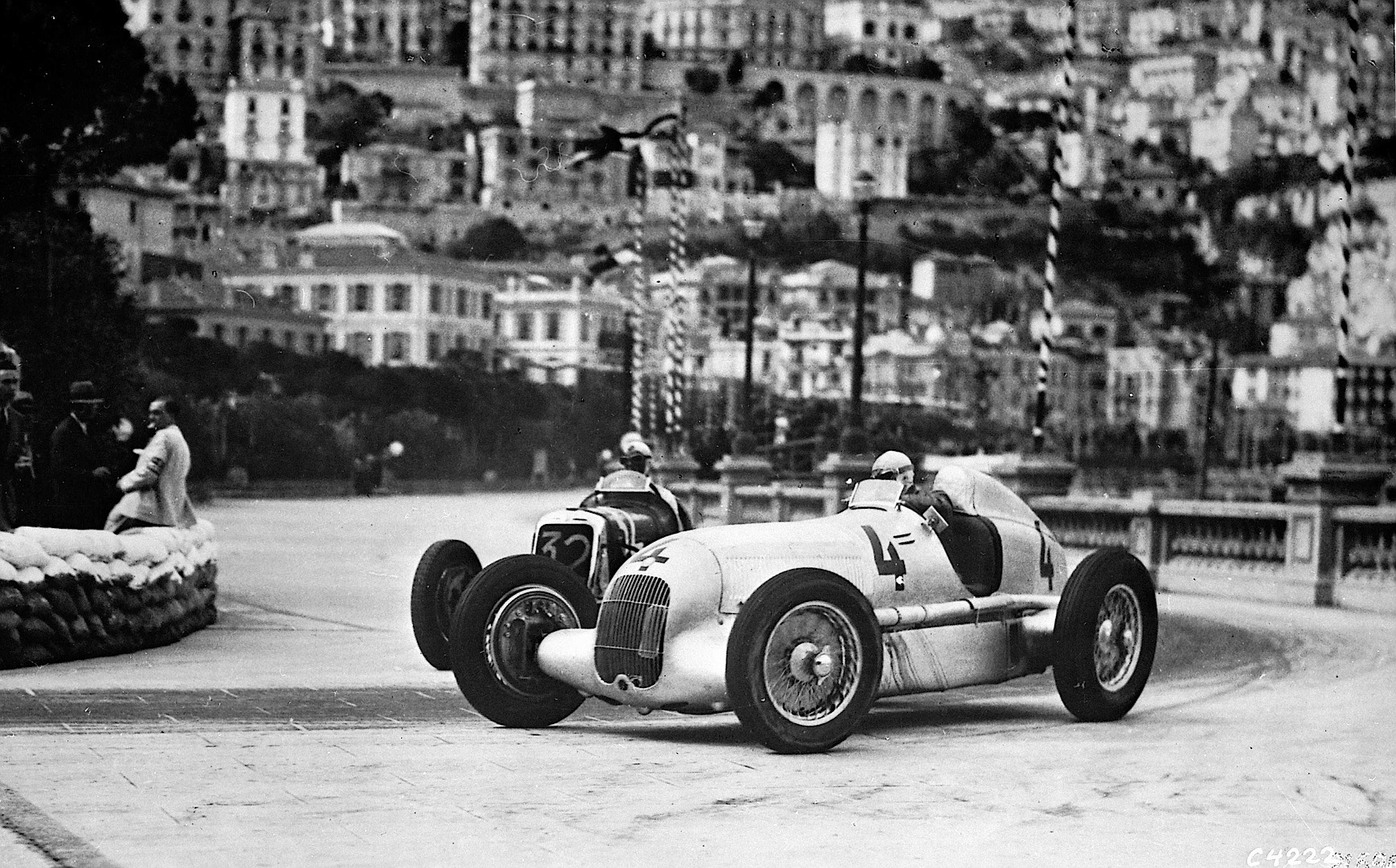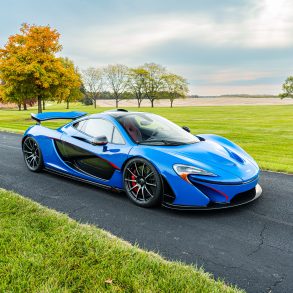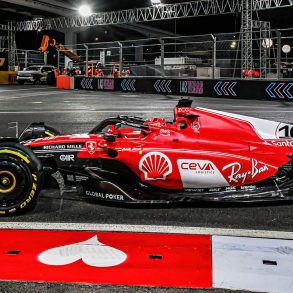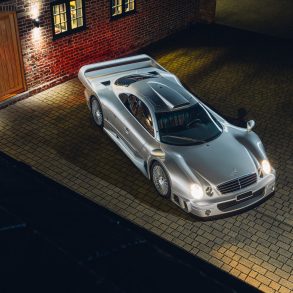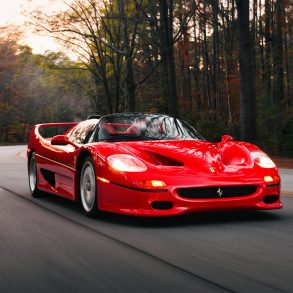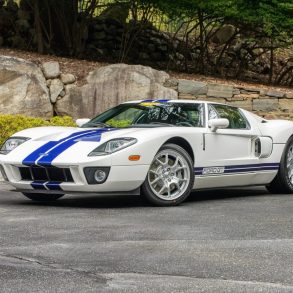The Circuits Dominated by The Silver Arrows
Avus
- Length: 19.29 km (11.98 miles)
- Fastest Lap: Rosemeyer (1937) – 276.32 km/h (171.74 mph)
The name of the trace is actually the initials of the proper name; Automobil Verkehrs und Ubungs Strasse which translates roughly to Automobile Traffic and Practice Street. Plans for the circuit were devised in 1907 as part of a national highway system but was not completed until 1921. The track was composed of two two-lane roads each 9.78 km (6.08 miles) separated by an 8 meter (26 ft) grass median strip. At the south end was a chicane while at the north end was a wide-radius loop later rebuilt with a 43 degree banking. In comparison the banking at Daytona International Speedway never exceeds 31 degrees! With a vertical concrete retaining wall at the top of the banking this was definitely a corner that would separate the men from the boys. Herman Lang’s winning 1937 race average was not bested at Indianapolis until 1967 by A.J. Foyt!
Belgrade
- Length: 2.79 km (1.73 miles)
- Fastest Lap: Nuvolari / von Brauchitsch – (1939) – 1 min. 14.0 sec. 135.1 km/h (83.9 mph)
The circuit is roughly triangular in shape and located inside a large park. The Grand Prix of Yugoslavia was the last Grand Prix run until after World War II. Held on the very day that England declared war on Germany the race was a sad affair with only five contestants including a very reluctant von Brauchitsch who had to be literally dragged off a plane bound for exile in Switzerland! The race was won by Nuvolari but sadly the great Silver Arrows had to return to Germany and race no more.
Bremgarten
- Length: 7.28 km (4.52 miles)
- Fastest Lap: Rosemeyer – (1936) – 2 min. 34.5 sec. 170.0 km/h (105.64 mph)
Because of the Swiss ban on motor racing the Swiss Grand Prix is no more but in the 30’s it was considered one of the premier tracks in the world, a real drivers circuit. Situated in a forest and located North – West of Bern it was scene of many great battles it was organized by a Monsieur Huber. A special signaling area had to be built on the inside of the track due to the distance of the actual pits.
Brno
- Length: 29.14 km (18.10 miles)
- Fastest Lap: Caracciola (1937) – 11 min. 59.3 sec. 145.9 km/h (90.66 mph)
The Masaryk Ring near Brno was the longest circuit used in Grand Prix racing in the 30’s. The site of the Czech Grand Prix was named after their founding President Thomas Garrigue Masaryk. Half the circuit used the national highway and the other half was on local district roads. The local roads were narrow and very bumpy. Because of the length of the circuit crowd control was problematical. In 1937 Herman Lang lost control and crashed into a crowd of spectators who were standing in a prohibited area.
Donington Park
- Length: 5.03 km (3.125 miles)
- Fastest Lap: Rosemeyer – (1937) – 2 min. 11.4 sec. 137.76 km/h (85.62 mph)
Donington is considered the first road racing circuit built in England. Under the leadership of Fred Cramer and the Derby and District Motor Club the circuit played host to to an international field in 1937. The European teams required ocean transport to make the event and both Auto Union and Mercedes set sail on the SS Bremen, the pride of Germany. The British fans had only just read about the fantastic German cars but nothing could prepare them for the awesome display of noise and power.
“The British spectators, who had read about these cars and only partly believed what they had read, were struck all of a heap. Even Fleet Street journalist were going about in a daze during the practicing, mouthing and gibbering.” Rodney Walkerley – The Motor
Monaco
- Length: 3.18 km (1.98 miles)
- Fastest Lap: Caracciola (1937) – 1 min. 46.5 sec. 107.49 km/h (66.79 mph)
“For days on end I went over the avenues of the Principality until I hit on the only possible circuit. This skirted the port, passing along the quay and the Boulevard Albert Premier, climbed the hill of Monte Carlo, then passed round the Place du Casino, took the downhill zig-zag near Monte Carlo Station to get back approximately to sea level and from there, along the Boulevard Louis II and the Tir aux Pigeons tunnel, the course came back to the port quayside. Today, the roads comprising this circuit look as though they were made for the purpose. But then!” This is how the birth of the famous round-the-house circuit was described by Anthony Noghes, Founder-President of the Automobile Club de Monaco took place in 1928. In 1934 the Monaco Grand Prix was one of the first races to award grid positions based on qualifying times rather than a lottery. The race was run from 1929 to 1938 before experiencing an eleven year hiatus because of money and political problems. The race, still largely unchanged is now the most prestigious event on the Formula One calendar.
Monza
- Length: 6.99 km (4.35 miles)
- Fastest Lap: Nuvolari (1938) – 2 min. 34.2 sec. 163.26 km/h (101.44 mph)
Built in 1922 by the Milan Automobile Club it allowed Milan to wrest control of the Italian Grand Prix from the rival club in Brescia. Situated in an old royal park in the town of Monza just north of Milan it was reputed to have been built in the space of 100 days. The circuit incorporates a banked speed bowl with 13 grandstands facing the main straight. During much of its life it was famous for close slip-streaming racing but in 1934 it was temporarily shortened with new chicanes added in the hopes of favoring the Italian teams over the new German race cars.
Nurburgring
- Length: 22.80 km (14.17 miles) (Nordschleife)
- Fastest Lap: Lang (1939) – 9 min. 52.2 sec.138.5 km/h (86.06 mph) (Eifelrennen)
The origins of the Nurburgring can be traced back to the Kaiserpreis in 1907. After the success of this inaugural race it was felt that Germany needed its own permanent circuit to be competitive with the French who dominated racing in the beginning of the century. A location in the Eifel Mountains near the town of Adenau was selected. World War I intruded and the project never got beyond the planning stages. After the war it was revived as a way to bring tourist and employment to an area of the country that was in desperate need of both. The organizers were led by a Councillor for the Eifel District, Dr Otto Creutz. The original plan as conceived by Dr Creutz was for a 28.27 km (17.56 miles) circuit consisting of two loops, a Sudschleife 7.75 km (4.81 miles) and a Nordschleife 22.8 km (14.17 miles). With the support of the government a veritable army of 25,000 construction workers built a course with 172 corners. With 88 left-handers and 84 right-handers the circuit rose from 310 m (1017 ft) above sea level to 616 m (2020 ft) at the start / finish line. A massive pit, grandstand and paddock complex was constructed. The paddock contained 70 garages similar to Gasoline Alley at Indianapolis. The entire complex cost a staggering 14.1 million Reichmarks. On June 18, 1927 150,000 fans saw the first race and the legend began.
Pau
- Length: 2.77 km (1.72 miles)
- Fastest Lap: von Brauchitsch (1939) – 1 min. 46.8 sec. 94.07 km/h (56.45 mph)
In 1933 a new circuit was built to replace the original which had been the site of the 1930 French Grand Prix. This new circuit would join Monaco as another round-the-houses race. The first Pau Grand Prix was scheduled in February and was promptly snowed out! Moved to April the race was successfully run for a number of years. In 1938 René Dreyfus upset the Mercedes team with a victory in a Delahaye.
Percara
- Length: 25.80 km (16.03 miles)
- Fastest Lap: Varzi (1935) – 10 min. 35 sec. 146.25 km/h (90.9 mph)
Pescara was a triangular circuit which involved two ultra-fast legs and a base that was both twisty and hilly. The Start / Finish line was along the Adriatic coast to the old fortress town of Pescara before making a sharp right hand turn and headed inland. Through a series of bends it went through the village of Spoltore and onto Cappelle sul Tavo, Then came the long downhill straight to Montesilvano Station, another sharp right-hand turn and along then Adriatic and the start of another lap. The circuit was used by all of the major car manufactures in Italy to test their cars and a victory in the Coppa Acerbo was considered a victory above all others.
Reims
- Length: 7.83 km (4.86 miles)
- Fastest Lap: Lang (1939) – 2 min. 32.9 sec. 182.46 km/h (113.38 mph)
Organized by the AC de Champagne, Reims included a massive permanent grandstand as well as permanent pits that were unmatched in their day. The triangular course utilized the Route Nationale No 31 before reaching a very tight right-hander onto the finish line straight then downhill again to the village of Gueux. Right turn and uphill the cars would race towards Garenne. Reims competed yearly for the honour of being the fastest road course in Europe.
Spa-Francorchamps
- Length: 14.50 km (9.06 miles)
- Fastest Lap: Lang (1937) – 5 min. 05 sec. 175.6 km/h (109.1 mph)
Still considered one of the greatest road courses in the world, the circuit is located in the Ardennes south-east of Liège. The circuit is known for its broad sweeping curves with numerous overtaking areas which when you are driving a Mercedes W 154 along the Masta straight at 310 km/h (193 mph) should not have been a problem! The most famous curve in all of racing, Eau Rouge still reigns supreme, in fact there used to be a hairpin just after the curve which was eliminated in 1939 allowing a tremendous run up the hill to Les Combs. Always treacherous because of the unpredictable weather, Spa was the scene of Richard Seaman’s fatal crash in 1937.
Tripoli
- Length: 13.14 km (8.14 miles)
- Fastest Lap: Stuck (1937) – 3 min. 25.7 sec. 229.22 km/h (142.44 mph)
The Mellaha circuit home of the Tripoli Grand Prix, used to be one of the fastest if not finest in the world. Situated on the North African coast, surrounding the Mellaha salt lake, it opened in 1925. The famous Italian aviator Marshal Italo Balbo was made Governor of the former Italian Protectorate (Libya). Acting upon a suggestion he combined the race with a state lottery. More than four million tickets were sold and some of the money was used to create a world class facility. The covered grandstand could hold 10,000 lucky spectators while the pits rivaled the best that Europe had to offer. The other famous landmark was the huge white concrete timing tower. The track was described by Dick Seaman as “The Ascot of motor racing circuits”, and its host Marshall Balbo entertained everyone royally at the palace. The teams would stay at the luxurious Hotel Uaddan which included a casino and dinner theatre. For these reasons the Grand Prix was very popular with all of the teams. Much as Monte Carlo is today.


